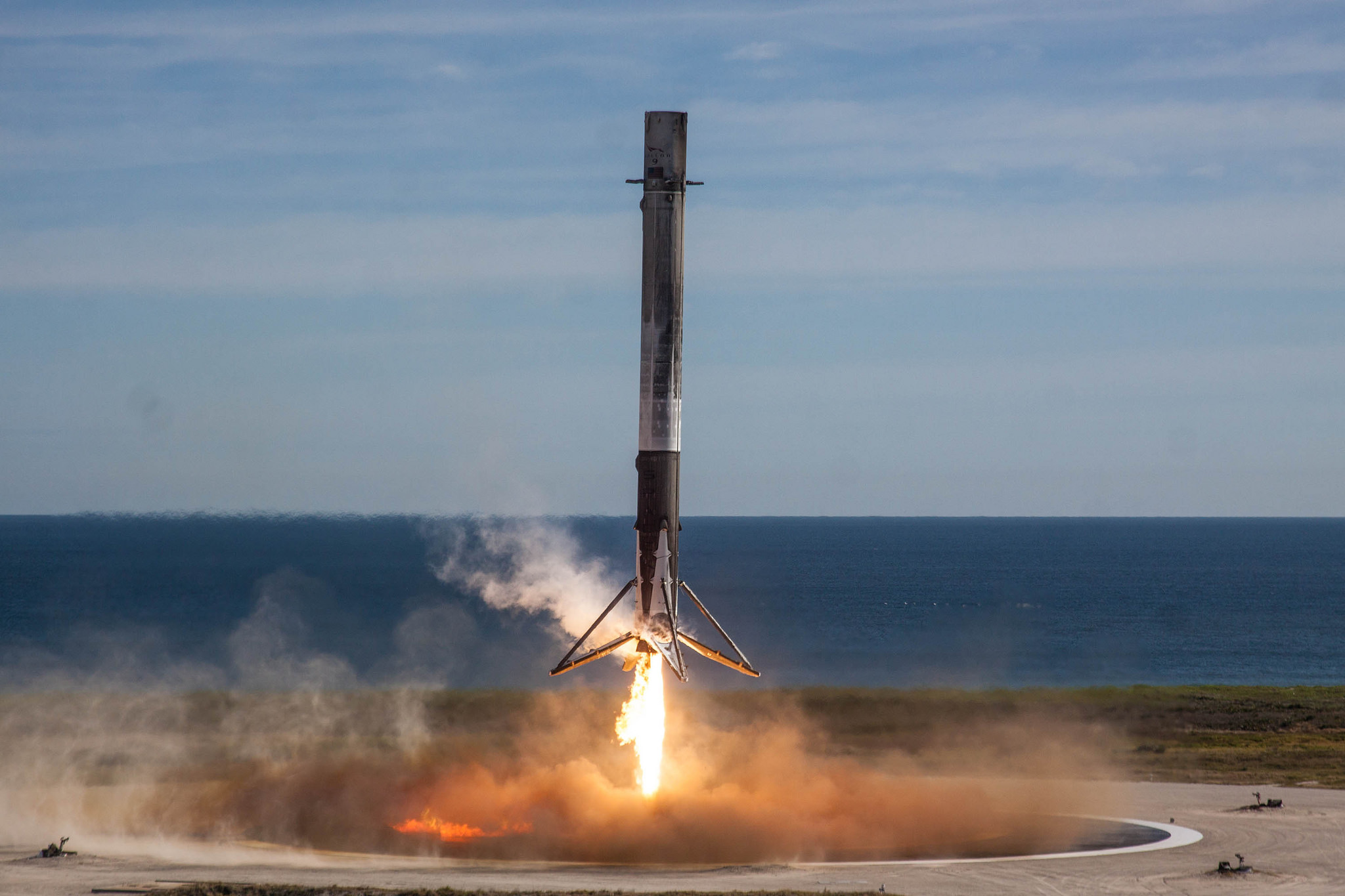For most watching the Falcon 9 rocket launch on Friday afternoon from Florida, the spectacle did not appear all that different from any SpaceX rocket launch and subsequent droneship landing. But sometimes, looks can be deceiving.
This rocket ascending into space had been almost entirely remade. After eight years of flying the Falcon 9 rocket, SpaceX has taken all of the lessons it has learned from 51 flights and engineered them into this new, and probably final, variant of the booster.
For most of this decade, the companys chief executive officer and lead designer, Elon Musk, has talked a good game about rapid and reusable launch. Now, the Block 5 version of the rocket may finally deliver on these promises. Musk held a teleconference with space reporters on Thursday afternoon, a day before the launch. Although he expressed the usual pre-flight jitters and did not want to take anything for granted, Musk said that after slogging through the Block 5 development process he is now convinced that rockets can be flown, landed, and flown again within 24 hours. “We still need to demonstrate it,” he said. “Its not like weve done it. But it can be done.”
Musk famously does not like to look backward and prefers to keep his gaze fixed on the future, but even he turned wistful next. For just a moment, he stopped to contemplate how hard he had pushed his engineering team at SpaceX to deliver the Block 5 rocket to the pad, to fly it, and then (hopefully) to land it.
“For those that know rockets, this is a ridiculously hard thing,” he said. “It has taken us since, man, since 2002. Sixteen years of extreme effort and many, many iterations, and thousands of small but important development changes to get to where we think this is even possible.”
He paused for a second, and then added, “Crazy hard.”
Block 5 changes
During the call, Musk discussed changes that SpaceX engineers have incorporated into the Block 5 variant of the rocket. The company has modified the first stage booster in almost every way, he said, to both maximize performance of the booster and increase its robustness. A more robust, reliable rocket is certainly good for reusability, Musk said, but more importantly the changes focus on increased safety as SpaceX eyes crewed flights with its Dragon spacecraft.
“The most important thing was addressing NASAs human rating requirements,” Musk said. “They are quite extensive.”
SpaceX continues to work with NASA to qualify its Falcon 9 rocket and Dragon spacecraft for crew missions, which may happen about a year from now. NASA has indicated it needs to see seven flights of the Block 5 version of the rocket before it is confident in the new configuration.
Among the most extensive changes to the new booster is a strengthening of the “Octaweb,” essentially the engine bay that carries the load of the Falcon 9s nine rocket engines and insulates them from one another in case an engine fails on ascent. By using 7000 series aluminum (instead of 2000 series), the Octaweb has a “much stronger” structure, Musk said, and it also has additional thermal protection.
The heat shield at the bottom of the rocket, which surrounds the engines and takes the brunt of heating during atmospheric reentry, has been changed from a “composite” structure to a “high grade titanium” structure. The rockets interstage and landing legs also have a new thermal protective system coating—this makes them look black—that does not require paint.
The performance of the Merlin engines, too, has been boosted by about 8 percent at sea level, Musk said. They now have 190,000 lbf of thrust at liftoff.
Reflight plans
During the call, Ars asked Musk how soon this first Block 5 booster would fly again, and then how soon again it would get to a third flight. This is critical, because each of the companys Falcon 9 rockets that have been used to date (there have been 11 of them) have been reused just a single time.
“We are going to be very rigorous in taking this rocket apart and confirming our design assumptions to be confident that is indeed able to be reused without taking apart,” Musk said. “Ironically, we need to take it apart to confirm it does not need to be taken apart.”
For this reason, Musk said the time between the first and second flight of the first Block 5 booster will measure several months. However, by the end of this year, he expects at least one of the new rockets to have flown three or even four times. By the end of 2019, Musk added, he anticipates that a Block 5 rocket probably will have reached 10 flights.

If everything works as SpaceX engineers hope, these rockets will not need any “regular maintenance” between each flight, and that such work would only be done every 10 flights or so. To demonstrate this is really the case, some time next year, SpaceX plans to launch a Block 5 booster and then refly it again within 24 hours. “Literally no actions taken, just like an aircraft,” Musk said.
In other words, after the rocket lands it will be rotated to a horizontal position, have its landing legs stowed, moved to an integration facility, have a an upper stage and then a payload fairing attached, and then be moved back to the launch pad. That is the goal Musk has set for his team. (Even a one-week turnaround for an orbital rocket would be both remarkable and unprecedented in the aerospace industry.)
Ultimately, SpaceX will probably build about 30 to 50 Block 5 rockets, Musk said. The final number depends on how many customers want to fly on a “new” booster, and how many will prefer a “flight proven” version. Over time, he expects the aerospace industrys preference for used boosters to increase as the technology proves itself.
The Block 5 rocket will probably fly about 300 missions over its lifetime, Musk said. After this time, he expects the Big Falcon Rocket now under development to supersede the smaller booster.
Cost-cutting
In recent months SpaceX has attempted to recover the $6 million payload fairing that splits into two after the launch of the Falcon 9 rocket and returns to the ocean. SpaceX also continues to study the feasibility of returning and reusing the second stage of the Falcon 9, and Musk said hes confident it can be done. The question is what “mass penalty” will have to be paid, primarily in terms of the fuel needed to slow the second stage down so that it can make a controlled descent back through Earth's atmosphere.
Still, Musk believes the Falcon 9 will get to full reusability. In terms of the rockets overall cost, the first stage accounts for 60 percent, the upper stage 20 percent, the fairing 10 percent, and the remainder are costs associated with the launch itself (fuel costs are between $300,000 and $500,000), Musk said.
Given this, eventually SpaceX could theoretically pare cost of a Falcon 9 launch to about 10 percent of the present-day base price for a Falcon 9 rocket, $62 million. However, during the conference call, Musk noted that “we have a bunch of fixed costs to cover,” and that the company will also need to recover the development costs for reusable rockets. Then, he needs to pay for Big Falcon Rocket development and the Starlink Internet satellite program.
In short, we probably should not expect the price of a Falcon 9 rocket to fall below the $50 million range for some time. (As discussed in our recent feature on the Block 5 rocket, there are few incentives for Musk to substantially drop the price, as he would only be undercutting the price of his already low-cost rocket.)
Musk said he appreciated that SpaceX has served as a “forcing function” to push the aerospace industry forward. China is developing a reusable rocket. Russia is cutting prices. US-based competitors are scrambling to develop boosters that can compete on price. A successful Block 5 rocket would certainly apply more force to that function.
[contf] [contfnew] 
Ars Technica
[contfnewc] [contfnewc]





